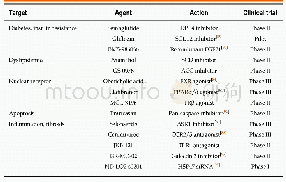《Table 3 Novel therapeutic agents for non-alcoholic fatty liver disease/non-alcoholic steatohepatiti
 提示:宽带有限、当前游客访问压缩模式
提示:宽带有限、当前游客访问压缩模式
本系列图表出处文件名:随高清版一同展现
《"Current status, problems, and perspectives of non-alcoholic fatty liver disease research"》
How do organs and cells crosstalk in NAFLD/NASH?Crosstalk among normal/steatotic hepatocytes,immune cells,HSCs and the organ network is anintriguing theme in the context of NAFLD/NASH pathogenesis.Especially,contribution of gut-liver axis and microbiota to NASH development is drawing much attention(Table 4)[94-96].Although the merits of direct manipulation of the intestinal microbiota with antibiotics,prebiotics,or probiotics are debatable for human NAFLD/NASH due to the sheer diversity of microbiota,modulation of the gut-liver axis to target microbiota-derived metabolites is considered an attractive option.For instance,microbiota-derived deoxycholate evoked senescence-associated secretory phenotypes in HSCs and facilitated HCC development in hepatocarcinogen-primed genetically obese or high fat diet-fed mice[97].Microbiota-derived taurocholate stimulated ceramide synthesis in enterocytes through FXR in mice,after which circulating ceramide promotes hepatic steatosis[28].However,the applicability of these mechanisms to humans remains unclear.Recently,it was reported that microbiotaderived short-chain fatty acids lowered resting regulatory T-cells and associated with systemic T-cell activation in humans[96].As such,discovering the pathogenic molecules that mediate organ/cell crosstalk and contribute to NAFLD/NASHdevelopment in humans will provide much needed insights into disease management[31,98].
| 图表编号 | XD0049331700 严禁用于非法目的 |
|---|---|
| 绘制时间 | 2019.01.14 |
| 作者 | Naoki Tanaka、Takefumi Kimura、Naoyuki Fujimori、Tadanobu Nagaya、Michiharu Komatsu、Eiji Tanaka |
| 绘制单位 | Department of Metabolic Regulation, Shinshu University School of Medicine、International Research Center for Agricultural Food Industry, Shinshu University、Department of Internal Medicine, Shinshu University School of Medicine、Department of Internal Medici |
| 更多格式 | 高清、无水印(增值服务) |





